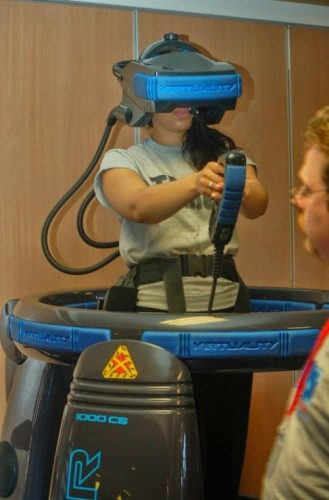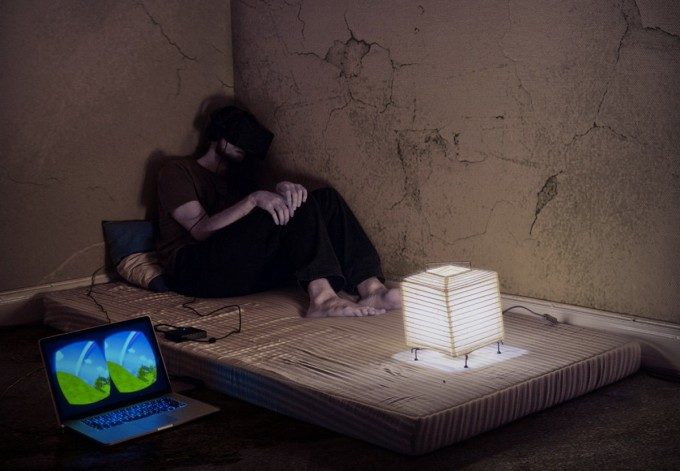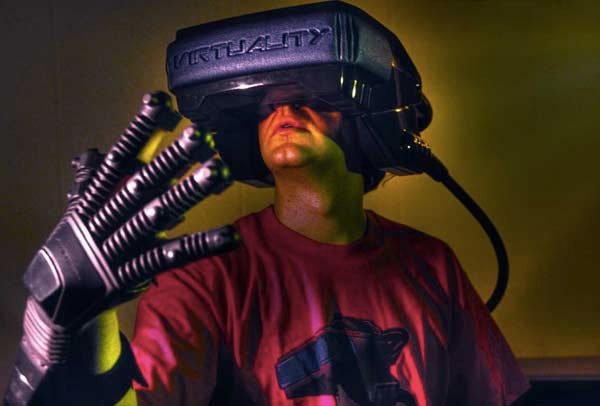Since beginning my journey learning and writing about VR in 2011, I’ve talked with hordes of believers and critics alike. Through it all, I’ve found three common arguments touted by skeptics of the adoption of VR in the consumer market. Having immersed myself in this new era of VR for years now, I feel confident in responding to these concerns.
“VR Already Failed”


First, virtual reality in the ’80s and ’90s never failed. Consumer VR—the kind that was good enough for entertainment and affordable for a single person—failed. But VR continued on to be used ever since as an invaluable tool in fields of simulation, research, design, and many other industries outside of the consumer landscape.
Second, adherents to this argument make a false equivalency between ’80s and ’90s VR and that of today (you’ll find this false equivalency fallacy to be a common theme through most arguments by VR skeptics). Anyone who utters the words ‘Virtual Boy’ in a sentence about why VR won’t work is especially guilty of this.
Virtual Boy was Nintendo’s famously failed ‘virtual reality’ console from 1995, but it wasn’t a ‘virtual reality’ system by any measure that we recognize today. No headtracking, no natural input, highly limited field of view—and did I mention that the display only had a single color? Red. This tongue-in-cheek guest article does a great job of explaining how incomparable Virtual Boy is with modern day immersive virtual reality.
Even the headsets from that earlier era that better fit into the ‘virtual reality’ category often had poor headtracking accuracy and latency, a limited field of view, and no positional tracking (which means limited immersion and nausea). Even if the best headsets of the era matched the performance that we see from the VR headsets of today they would still be significantly heavier, bulkier, and cost tens of thousands of dollars, pricing them right out of any shot of a consumer market.
Then there’s the fact that the PC and computer graphics industries have advanced exponentially over 25 years, meaning widespread powerhouse computing devices capable of rendering near-photorealistic real-time graphics at high framerates. Something that didn’t exist at that time.
More simply put, VR has entered a new epoch.
“3DTV Failed and VR is 3D so it Will Fail Too”
At the root, this is another claim that falls into the false equivalency bucket. The argument has two common prongs: first is that 3DTV failed because people don’t like to wear something on their head while enjoying entertainment. And since VR headsets are like a bigger and heavier version of 3D glasses, VR will fail. Second is that stereoscopic 3D simply isn’t compelling enough to warrant its use, and since VR is 3D it also isn’t compelling enough. Let’s look at these one by one.
Regarding the idea that ‘people don’t want to wear something to enjoy entertainment;’ this premise is demonstrably wrong in the case of headphones for music players. And size is clearly not a limitation as large headphones are becoming increasingly popular. The fact is that there’s an inverse relationship between how much someone cares about how they look (or how uncomfortable it is to wear something on their head) and the experience they’re getting. More simply put, as long as the experience provided by the VR headset is good enough, people will be willing to wear one; they will gladly sacrifice looking cool or wearing something that isn’t perfectly comfortable to obtain a great experience. 3DTV didn’t fail because people didn’t want to wear glasses, it failed because the added benefit of 3DTV compared to normal TV did not justify the downsides of wearing the glasses.
When it comes to whether or not stereoscopic 3D actually adds anything to a media experience, it should first be known that I’m one of the biggest 3DTV/movie haters out there. Given the choice between a 3D movie and a 2D movie in theaters, I’ll always pick 2D. And I never even considered buying a 3DTV. But VR is an entirely different beast (that is to say: this argument is another false equivalency).
One major reason is that the 3D effect is ultimately limited by the size of the frame. A 3DTV may be able to make an object in the center of the screen appear as though it is floating outside of the frame toward the viewer, but as soon as that object moves to the edge of the screen, it cannot go beyond it out into space as its stereoscopic distance suggests. This immediately defeats the illusion and leaves only a small portion of the screen available for convincing depth. But if you remove the edges of the screen, objects can float ‘anywhere’ within the space around you.
That’s a long way to say that while 3D is a part of what makes VR immersive, it’s way more immersive than anything you’ve seen on a 3DTV and, to wrap this up into the other part of the broader 3DTV argument, the added experience justifies wearing a headset.
“The Kinect Failed Because Gamers Don’t Find Gesture Input Compelling and They Don’t Have Room, VR Will Have the Same Problem”
‘Gesture input is not compelling.’ I agree 100%.
‘Gestures’ are abstract actions designed to be detected by some form of gesture tracking and then converted into binary input (ultimately no different than the press of a button). Like waving your arms to turn your head or standing up to open the hatch of a tank. All of which is abstract, unnatural, unintuitive, and not helped by Kinect’s high latency and inconsistent tracking.
Fortunately, the best VR systems in development today do not use ‘gesture’ input. Instead they use ‘natural input’: one-to-one high precision, low latency tracking without gestures. Want to open that door? Reach out your hand, grip the actual handle and pull. Want to pick up the gun sitting on the desk? Walk over to it, reach out and physically pick it up. Aim by holding your arm up to your head and looking down the iron-sights. When you’re done, drop the clip and physically slide in a new one. There’s no gestures here, just you and your hands inside the game world, interacting with objects like any human would in the real world.
The second half of this argument is about the space needed for larger experiences like those ‘room-scale’ experiences targeted by the HTC Vive. Critics of the Kinect say that people aren’t willing to make room for these sorts of experiences. I say that people will be happy to make room as long as the experience is good enough for them to justify it.
Before the TV was invented, no one had a ‘TV room’. But when it came along, the experience was so compelling that billions now have a TV room in their home. The ‘cost’ of dedicating the space to the TV was outweighed by the experience provided.
The experience afforded by the latest VR systems is leaps and bounds beyond what the Kinect provides, and I’m willing to wager that people will be happy to sacrifice space for the experience. In fact, VR systems may end up annexing the existing TV room space in many cases. If I had to choose between a TV room and a room-scale VR system like the HTC Vive, I would take the VR system without hesitation.
One frequent commonality between purveyors of these arguments is that they haven’t tried the modern wave of consumer VR for themselves. Generally proponents of these arguments had tried ’90s VR once upon a time or haven’t tried any VR at all and are only working from broad assumptions, leading to false equivalencies between technologies that may seem related but are actually substantially different upon investigation.


